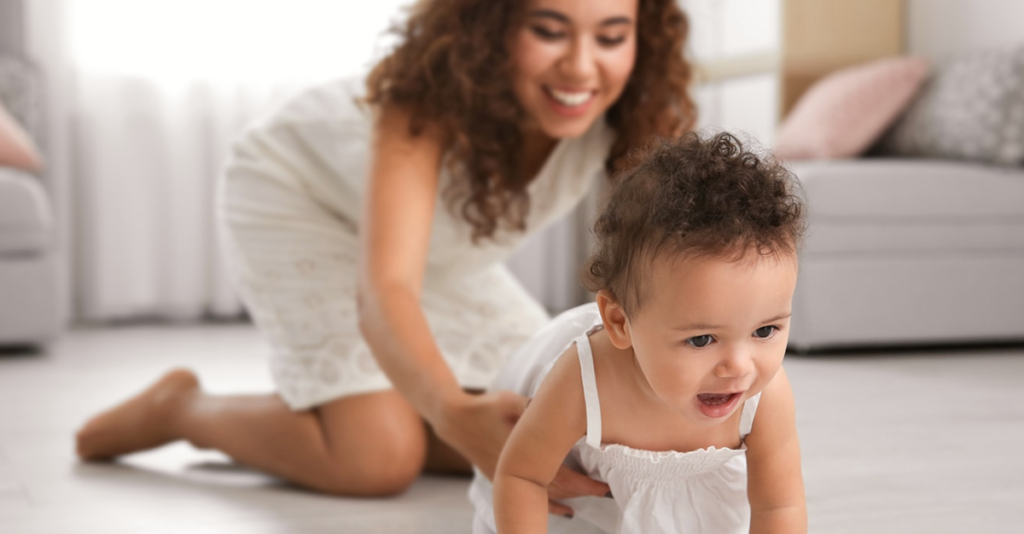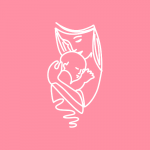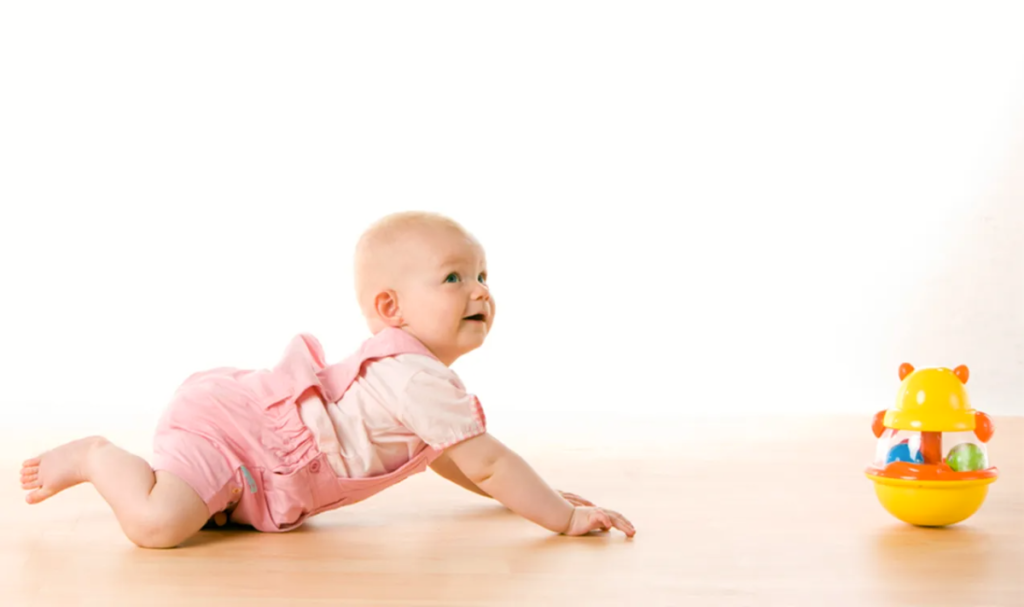What age do babies crawl? As a parent, watching your baby reach developmental milestones is one of the most rewarding experiences. Crawling in particular marks an important step on their journey toward independence and mobility! The average age for babies to start crawling usually falls between seven and eight months old — but this can vary from child to child. With patience and understanding of each stage of development, you’ll be able to better nurture your growing infant’s unique path toward discovering their world!

Uncovering the mystery of when babies take their first strides towards mobility—crawling! From around six months, your little one might start to become more curious about their environment. Learn how you can help encourage crawling and set them on course for a life full of exploration.
Pros And Cons of Babies Crawling
Crawling is an essential ability for babies to grow and develop, enabling them to strengthen their balance, coordination, and motor skills. Although it may be challenging at times due to its tiring nature, the courage of infants and toddlers striving towards improved mobility through crawling should not go unnoticed!
Pros of crawling include the following:
Developing the necessary skills for walking, infants and toddlers use crawling to hone their balance, coordination, and motor abilities. With every inch of progress they make on hands-and-knees or tummy time practice; these little ones are building a strong foundation for physical success in life!
An exciting way to bond with your little one, crawling is the perfect activity for parents and babies alike! Not only does it gives infants a chance to explore their developing muscles in an interactive manner, but also provides countless opportunities for memorable shared moments.
Babies and toddlers can benefit from the thrill of crawling! It’s an excellent way to keep them entertained while they develop their motor skills, explore new places, and stay close by.
Crawling is a natural, fun way for parents to bond with their babies and toddlers. Get down on the floor at your child’s level to explore together – it not only encourages interactive playtime but strengthens muscles in developing bodies as well!
Through crawling, infants and young children can gain the necessary skills to explore their environment safely. As they wiggle around on all fours, coordination between hand-eye movements is developed as well as strength in muscles needed for exploring!
Cons of crawling include the following:
Babies take an important milestone when they learn to crawl – although it may be exhausting, this skill is a sign of their growing coordination and strength!
As babies and toddlers learn to move around, crawling can be a struggle. But it is an essential skill they will use as they continue on their journey of developmental growth!
Crawling is an important part of infant development, but it can have dangers associated with it. Babies who crawl may be at risk of falling and suffering from an injury due to their lack of balance or coordination. It’s essential that parents provide a safe environment in which babies can explore without worry!
The Developmental Stages of a Babies Crawling
As babies enter their first year of life, they’re embarking on a special journey – the developmental phase known as crawling. During this time, little ones start to gain independence and begin exploring the world around them by moving both hands and legs in an alternating fashion! It’s truly fascinating how rapidly developing brains learn complex motions like these; it helps them become more aware, adventurous explorers of all that surrounds them.
Early signs of crawling
As your baby grows, their curiosity and enthusiasm for exploration intensify! Starting at around six months old, crawling is the first way they experience life beyond arm’s reach. Over the next two or three years this process continues to develop as your child eagerly dives into discovering all that’s out there in curious anticipation.
Crawling is an important milestone for babies, not just in terms of development but also exploration! As they trek around on hands and knees or use their arms and legs to defy gravity, curious little ones gain perspective as well as a better understanding of their surroundings.
As your little one transitions from infant to toddler, they’re exploring their newfound freedom of movement – and that means it’s time for them to start crawling! Crawling helps babies learn how to move around the world safely, build strength in muscles critical for mobility later on, and discover new objects or people.
What age do babies crawl?
Six months of age marks an exciting milestone for babies—crawling! This natural process is more than just movement and exploration; crawling helps tote the development of coordination, a fundamental skill shared between humans. Through play, curiosity, and crawling, little explorers can venture into their world with confidence right at six months old!
How to encourage your baby to start crawling
At what age do babies usually begin to crawl? Generally speaking, it’s around 8-10 months old. However, there are several things you can do to get your little one exploring their environment earlier! Placing toys that encourage crawling at arm’s length is a great way for them to practice and build strength as well as providing activities specifically designed for motor skill development. Before you know it they’ll be racing across the room in no time!
The Different Types of Crawling
Babies Cross-crawling
Babies can reap great physical and mental benefits from cross-crawling! It helps them stay active by boosting coordination, strengthening their muscles, and improving balance. Plus, it’s an entertaining way for your little one to learn motor skills necessary for development.
Babies Belly crawling
Exploring the world – it’s a baby thing! Babies begin engaging with their environment by belly crawling at around 12 months old. This instinctual movement helps them to discover new things, giving parents plenty of opportunities for learning together as they grow and play.
Through crawling, babies become little adventurers! This dynamic movement boosts their physical development while helping them to understand and experience the world around them. Crawling helps improve balance, coordination, and mobility as they explore different sensations – from grass beneath their fingers to a toy’s texture in their hand.
Babies’ Bottom shuffling, Crawling.
Babies are born to explore! Crawling is a major milestone that encourages babies as young as four months old to move their bodies and experience the world around them. This special activity helps develop gross motor skills, coordination, and balance – all of which will come in handy for walking about 9-12 months later on!
Tips for Parents
How to create a safe environment for your baby to explore and crawl
Looking for ways to make your home safe and secure for your baby’s exploration? Why not create a special playroom just for little ones? Make sure it is spacious enough that they can move around, but still prevent them from getting lost. Include fun toys that are easy on the eyes -and soft on those tiny fingers- as well as furniture items specifically designed with safety in mind so you don’t have any surprises down the line.
What signs indicate that your baby is ready to start crawling
While some babies start crawling at a speedy six months, others may need more time to get moving – up to nine months or beyond. If your baby seems slow in reaching this milestone, you might consider having someone watch while they play and see if they’re starting on their own; but don’t worry unduly – it could be simply a natural variation between children! If there’s still no progress after that though, it would be wise for them to have an evaluation with the doctor.
Fun activities and games to help your baby learn to crawl
Help your baby develop important physical skills and have fun at the same time with these playful activities and games designed to foster crawling! From tummy time with different textures on their stomach, placing objects just out of reach for them to grab, or providing encouragement as they ‘inchworm’ across the floor – there are plenty of exciting ways you can stimulate learning.
- Crawling on all fours: Give your little one a head start in their crawling journey by having them begin on all fours. As they become comfortable with that, progress to the more advanced and challenging tummy crawl!
- Playing “Crawl: The Game”: Get ready for some exciting, tactile discovery with your little one! Introduce them to the amazing world of size differences. Gather a selection of small items such as balls and larger objects like blocks. Encourage the baby to make their way across the room towards each item in turn – picking up smaller ones before placing down bigger pieces again. A fun game that also helps hone essential motor skills!
- Crawling on their tummy: Learning to crawl is an exciting milestone in a baby’s life! To help them along, place your little one tummy down and encourage their limbs to move outwards. With practice, they’ll soon be gliding across the room with ease – what fun for everyone!
- Introduce babies to a stimulating and inspiring world of movement with toys that will foster their physical development. From crawling, pushing boundaries through exploration, or discovering kinetic play – these fun-filled activities promote an exciting journey for growing minds!

Conclusion
Supporting your baby’s growth is an important part of the parenting journey! Crawling plays a key role in helping babies reach other milestones, including standing and walking. While all little ones develop at different rates, generally speaking, most will begin to crawl between 6-10 months old. Knowing these facts can help parents ensure their little one is staying on track with development goals!
Caregivers are the key to helping their baby reach its milestone of crawling! By providing a supportive, nurturing environment full of stimulating objects and toys – coupled with patience, understanding, and love – you can help your little one discover this exciting new stage in growth.
If you are a new parent or becoming a parent, I hope this blog helps you understand what age babies crawl. And if you find it helpful, please share this with your loved ones and friends. You are also welcome to visit our blog section for more parenting tips and recommendations.
Reading suggestions:
What Teeth Do Kids Lose: The Toothless Journey!
When Do Babies Laugh: Unlocking The Mystery Of Baby Laughter!


